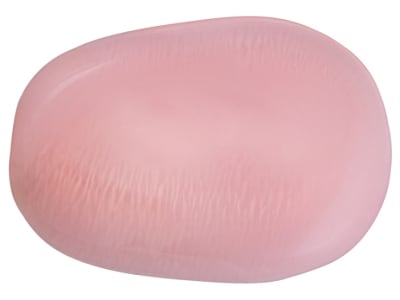Conch pearls are harvested from the giant conch Alger gigas formerly as Strombus gigas better known as the “Queen Conch” or “true conch”. The name comes from the Latin or Greek word conchos meaning shell. Conch pearls are non-nacreous, so they are not considered true pearls. The “Queen Conch” can only be found in the Caribbean Sea. Most conch pearls are collected as a byproduct of harvesting the shells for their meat. It has been stated that at the height of harvesting in the late 1970’s only 1 in 15,000 shells produced a conch pearl. In 1992 the species was included on Appendix II of CITES list of endangered species. In September 2003 the Dominican Republic and Honduras decided to stop all exports of the “Queen Conch”. The pearls have a porcelain luster and distinctive flame structure. The pearls can be white, pink, orange, or brown but the pink or salmon colors are the most desirable. The color is a result of organic compounds in the pearl layers. It is thought that they are made up of mostly aragonite with some calcite and water. They can grow to 20mm but pearls above 10 carats are rare. Some of the largest pearls have achieved 45carats.
General Information
LWUV: Variable
Conch Pearl Colors
-
 Brown
Brown -
 Pink
Pink -
 Pink
Pink -
 White
White -
 Yellow
Yellow
Alternate Names
Pink pearl
Countries of Origin
Colombia; Puerto Rico; United States of America; Aruba; Belize; Saint Vincent And The Grenadines; Bahamas; Costa Rica; Grenada; Virgin Islands (U.S.); Cuba; Barbados; Unknown; Saint Barthelemy; Panama; Brazil; Dominican Republic; Honduras; Martinique; Mexico; Turks and Caicos Islands; Bermuda; Jamaica; Venezuela (Bolivarian Republic of)
History
The early Spanish explorers reported that the Native Americans in Florida wore large pink pearls. It is believed that the first “Queen Conch” shells were brought to Europe by Columbus. Carl Linnaeus classified the species in 1758. Two conch pearls were reported in the collection of Henry Phillip Hope in 1839. Karl August Möbius, a German Zoologist, wrote in 1857 that he had found conch pearls at a local jeweler in Hamburg, Germany. Demand for pearl jewelry rose in the mid to late 1800’s as Queen Alexandria, wife of Edward VII, had a passion for pearls and they were popular in Edwardian jewelry. Queen Mary, the wife of King George V, had a conch pearl brooch that contained two natural pink conch pearls weighing 24.9 and 28.1 carats. Art Nouveau jewelry designer René Jules Lalique used conch pearls in some of his designs. In the early 1900’s Tiffany’s used conch pearls from the Bahamas in a line of jewelry. The demand for conch pearls declined with the rise of The Art Deco Movement. Conch pearls came back onto fashion in the 1970’s when conch meat began to be sold in the United States. The popularity of conch pearl jewelry probably hit its height in the 1990’s. Overfishing of the “Queen Conch” led to a decline in the species population. In 1992 CITES added it to their list of endangered species. In 1933 a biological researcher named La Place Bostwick published an account of successfully culturing conch pearls, but he took his pearl culturing secrets to the grave. Between 2006 to 2009, Drs. Héctor Acosta-Salmón and Megan Davis at Harbor Branch Oceanographic Institute at Florida Atlantic University (HBOI-FAU) developed a reliable technique to cultivate cultured conch pearls. In 2010 the company Rose Pearl, LLC, was created to bring cultured conch pearls to the market.
Care
Avoid cosmetics, perfumes, hairsprays, heat and household chemicals. Color may fade if pearl is exposed to sunlight for long periods of time.
